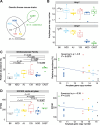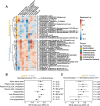Systems genetics uncovers associations among host amylase locus, gut microbiome, and metabolic traits in mice
- PMID: 40259344
- PMCID: PMC12012960
- DOI: 10.1186/s40168-025-02093-y
Systems genetics uncovers associations among host amylase locus, gut microbiome, and metabolic traits in mice
Abstract
Background: Population studies have revealed associations between host genetic and gut microbiome in humans and mice. However, the molecular bases for how host genetic variation impacts the gut microbial community and bacterial metabolic niches remain largely unknown.
Results: We leveraged 90 inbred hyperlipidemic mouse strains from the hybrid mouse diversity panel (HMDP), previously studied for a variety of cardio-metabolic traits. Metagenomic analysis of cecal DNA followed by genome-wide association analysis identified genomic loci that were associated with microbial enterotypes in the gut. Among these, we detected a genetic locus surrounding multiple amylase genes that were associated with abundances of Firmicutes (Lachnospiraceae family) and Bacteroidetes (Muribaculaceae family) taxa encoding distinct starch and sugar degrading capabilities. The genetic variants at the amylase gene locus were associated with distinct gut microbial communities (enterotypes) with different predicted metabolic capacities for carbohydrate degradation. Mendelian randomization analysis revealed host phenotypes, including liver fibrosis and plasma HDL-cholesterol levels, that were associated with gut microbiome enterotypes.
Conclusions: This work reveals novel relationships among host genetic variation, gut microbial enterotypes, and host metabolic traits and supports the notion that variation of host amylase may represent a key determinant of gut microbiome in mice. Video Abstract.
Keywords: Genetic association study; Gut microbiome; Hybrid mouse diversity panel; Metagenomics; Systems genetics.
© 2025. The Author(s).
Conflict of interest statement
Declarations. Ethics approval and consent to participate: Animal care and study protocols were approved by the AAALAC-accredited Institutional Animal Care and Use Committee of the College of Agricultural Life Sciences at the University of Wisconsin-Madison (UW-Madison). All experiments with mice were performed under protocols approved by the UW-Madison Animal Care and Use Committee. Consent for publication: Not applicable. Competing interests: The authors declare no competing interests.
Figures




Update of
-
Systems genetics approach uncovers associations between host amylase locus, gut microbiome and metabolic traits in hyperlipidemic mice.bioRxiv [Preprint]. 2024 Mar 3:2024.02.28.582610. doi: 10.1101/2024.02.28.582610. bioRxiv. 2024. Update in: Microbiome. 2025 Apr 21;13(1):101. doi: 10.1186/s40168-025-02093-y. PMID: 38464150 Free PMC article. Updated. Preprint.
Similar articles
-
Systems genetics approach uncovers associations between host amylase locus, gut microbiome and metabolic traits in hyperlipidemic mice.bioRxiv [Preprint]. 2024 Mar 3:2024.02.28.582610. doi: 10.1101/2024.02.28.582610. bioRxiv. 2024. Update in: Microbiome. 2025 Apr 21;13(1):101. doi: 10.1186/s40168-025-02093-y. PMID: 38464150 Free PMC article. Updated. Preprint.
-
A relationship between body size and the gut microbiome suggests a conservation strategy.Microbiol Spectr. 2025 Jul;13(7):e0029425. doi: 10.1128/spectrum.00294-25. Epub 2025 May 21. Microbiol Spectr. 2025. PMID: 40396732 Free PMC article.
-
Temporal dynamics and metagenomics of phosphorothioate epigenomes in the human gut microbiome.Microbiome. 2025 Mar 24;13(1):81. doi: 10.1186/s40168-025-02071-4. Microbiome. 2025. PMID: 40128848 Free PMC article.
-
Intestinal dysbiosis in preterm infants preceding necrotizing enterocolitis: a systematic review and meta-analysis.Microbiome. 2017 Mar 9;5(1):31. doi: 10.1186/s40168-017-0248-8. Microbiome. 2017. PMID: 28274256 Free PMC article.
-
Gut Microbiome Characteristics in IgA Nephropathy: Qualitative and Quantitative Analysis from Observational Studies.Front Cell Infect Microbiol. 2022 May 17;12:904401. doi: 10.3389/fcimb.2022.904401. eCollection 2022. Front Cell Infect Microbiol. 2022. PMID: 35656030 Free PMC article.
References
MeSH terms
Substances
Grants and funding
LinkOut - more resources
Full Text Sources

